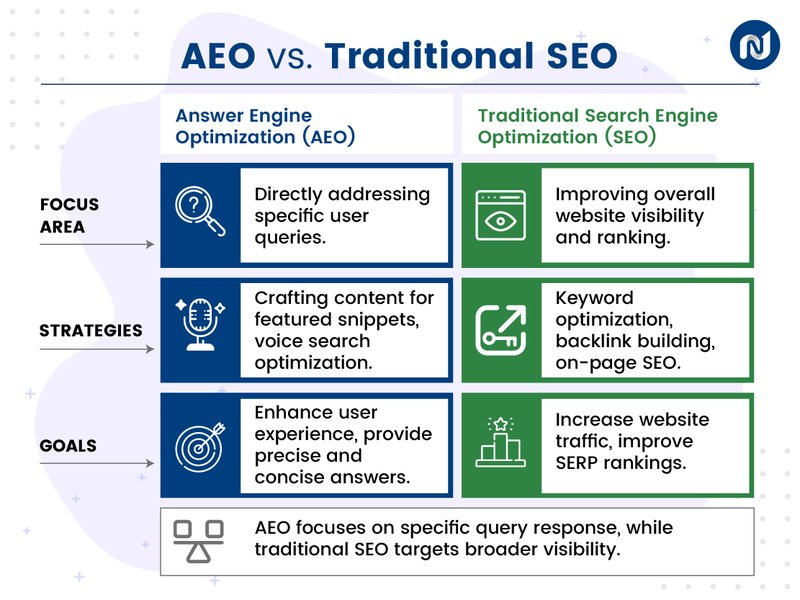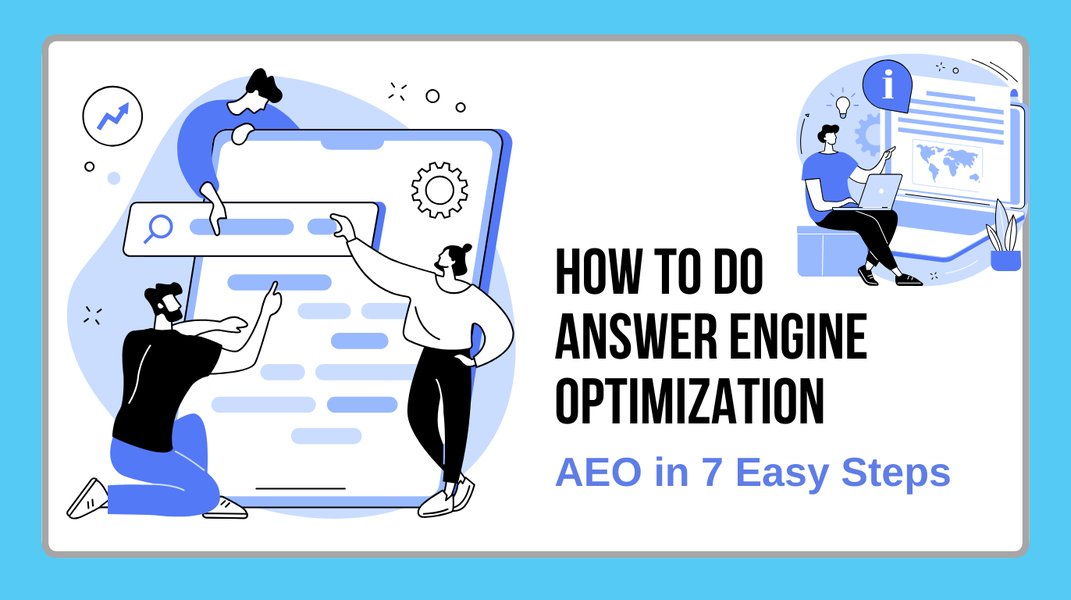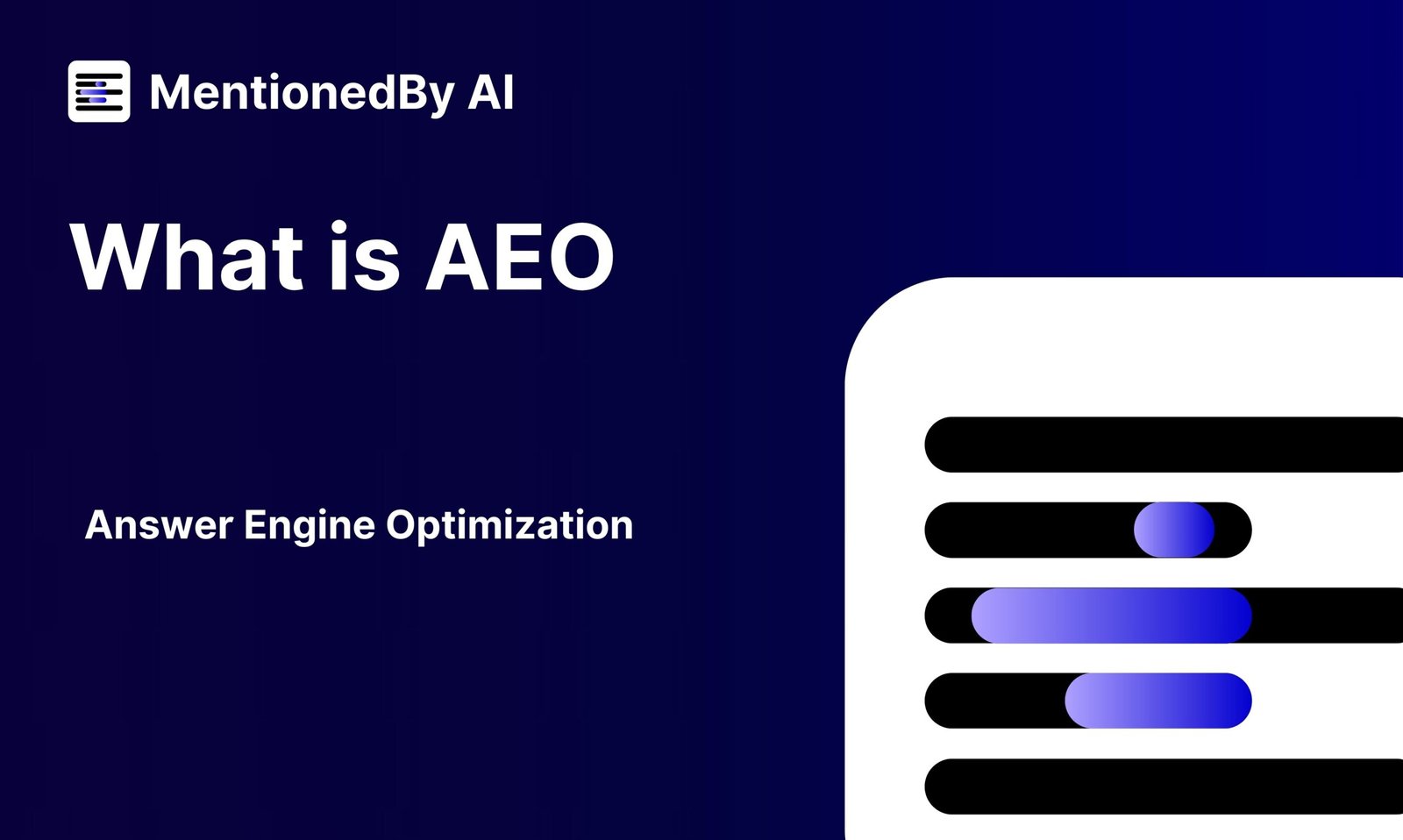In the rapidly evolving landscape of digital information retrieval, a new paradigm known as Answer Engine Optimization (AEO) has emerged. As users increasingly turn to AI-powered assistants, chatbots, and advanced search features for immediate and direct answers, AEO focuses on tailoring online content to meet these specific needs. This approach moves beyond traditional Search Engine Optimization (SEO) by prioritizing the delivery of concise, accurate information directly within search interfaces or AI responses, often eliminating the need for users to click through to a website.
Key Insights into Answer Engine Optimization
- AEO prioritizes direct answers: Unlike SEO which aims for website traffic through rankings, AEO focuses on getting your content featured as the direct answer by AI systems, voice assistants, and in search snippets.
- Structured content is crucial: Utilizing schema markup, clear formatting (like FAQs, lists, and headings), and concise language helps AI engines easily understand, extract, and present your information.
- User intent is paramount: AEO revolves around understanding and directly addressing specific, often question-based, user queries, particularly long-tail keywords that mimic natural conversation.
Defining Answer Engine Optimization (AEO)
What Exactly is AEO?
Answer Engine Optimization (AEO) is a specialized digital marketing strategy centered on optimizing online content so that it can be directly extracted, cited, and prominently featured by AI-driven answer engines and large language models (LLMs). These platforms include conversational AI like ChatGPT, Google Gemini, Claude, and Perplexity AI, as well as search engine features such as featured snippets, knowledge panels, Google’s AI Overviews, and responses from voice assistants like Siri and Alexa. The core objective of AEO is to ensure your content is the most readable, crawlable, and presentable resource for AI systems seeking to provide immediate and precise answers to user questions.
The rise of these sophisticated AI tools signifies a shift in user behavior: people increasingly expect instant, well-packaged information directly within the search interface or via conversational AI, rather than sifting through multiple web pages. AEO addresses this by strategically preparing content to be the source of these direct answers.
Visual representation of AEO’s role in the digital ecosystem.
The Ascendance of AEO in an AI-Powered Era
As of May 7, 2025, the integration of AI into search and information retrieval has accelerated the importance of AEO. Traditional search engines are evolving into answer engines, fundamentally changing how users interact with information online. This evolution means businesses and content creators must adapt their strategies to ensure their information is not just discoverable, but directly usable by these AI systems. AEO is about influencing the datasets and feedback loops of generative AI models to ensure a brand’s accurate and intentional presence in relevant answer spaces.
AEO vs. Traditional SEO: A Comparative Look
While AEO can be considered a subfield or an evolution of SEO, there are distinct differences in their goals, methodologies, and focus areas. Understanding these distinctions is key to implementing a comprehensive digital strategy.

Infographic highlighting the differences between AEO and traditional SEO approaches.
Core Distinctions
The following table outlines the primary differences between Answer Engine Optimization and traditional Search Engine Optimization:
| Feature | Answer Engine Optimization (AEO) | Traditional SEO |
|---|---|---|
| Primary Goal | Deliver direct, concise answers to specific user queries; achieve “zero-click” visibility. | Improve website rankings in SERPs for broad keyword visibility; drive users to a website. |
| Content Format | Emphasizes formats easily extracted for featured snippets, voice search responses, AI summaries, and FAQ answers (e.g., lists, direct statements, Q&A). | Utilizes various formats like long-form blog posts, web pages, articles, and landing pages. |
| Keyword Focus | Concentrates on long-tail, question-based keywords (e.g., “How do I…”, “What is…”, “Why does…”). | Uses both short-tail (broad) and long-tail (more specific) keywords. |
| User Intent | Serves users seeking immediate, specific answers, often without further site exploration. | Attracts users for further exploration of content on the website. |
| Main Search Method | Crucial for AI-driven voice searches, chatbot interactions, and AI-generated search summaries. | Primarily addresses desktop and mobile web searches via traditional search engines. |
| Click Dependency | Often aims for “zero-click” answers where the user gets information without visiting the site, though being cited can build authority. | Relies heavily on click-through rates (CTR) to measure success. |
AEO and SEO: A Synergistic Relationship
It’s important to note that AEO does not replace SEO; rather, it complements it. A robust digital strategy will incorporate both. SEO lays the foundation for discoverability, while AEO fine-tunes content to be directly answer-providing. Optimizing for both can lead to higher rankings in standard search results and prominent placement in answer boxes, maximizing overall organic traffic and visibility.
Visualizing AEO vs. SEO Dynamics
To better understand the nuanced differences and overlapping areas between Answer Engine Optimization (AEO) and traditional Search Engine Optimization (SEO), a radar chart can illustrate their varying emphasis on key strategic components. This chart visualizes how each approach prioritizes different aspects of digital content strategy, from user intent focus to platform targeting.

As the radar chart illustrates, AEO places a higher emphasis on user intent specificity, question-based keywords, and providing direct answers, often with less reliance on clicks. Conversely, traditional SEO generally has a broader keyword strategy and is more dependent on driving clicks to a website through SERP rankings. Both are vital, but their focus areas diverge based on evolving user behaviors and search technologies.
Core Strategies for Effective Answer Engine Optimization
Implementing AEO effectively requires a shift in content creation and optimization mindset. The following strategies are crucial for ensuring your content is primed for answer engines:

1. Providing Direct and Clear Answers
Focus on Brevity and Precision
Structure your content to directly address potential user questions. Start with the answer upfront, then elaborate if necessary. Use clear, concise language that AI can easily parse. FAQ sections are particularly effective, as they naturally align with question-answer formats.
2. Utilizing Structured Data (Schema Markup)
Helping AI Understand Your Content
Implement relevant schema markup (e.g., FAQPage, HowTo, QAPage from Schema.org) to provide explicit context to search engines and AI models. This markup helps these systems understand the nature of your content (e.g., it’s a question and answer, a step-by-step guide) and categorize it more effectively, significantly boosting its chances of being featured in quick response formats.
Conceptualizing the structured approach for AEO implementation.
3. Optimizing for Voice Search and Conversational Queries
Think in Natural Language
With the proliferation of voice-activated devices, optimizing for natural language queries is paramount. Content should be written in a conversational tone and address long-tail keywords that reflect how people actually speak when asking questions.
4. Formatting for Readability and AI Extraction
Clarity Through Structure
Employ formatting techniques such as clear headings (H1, H2, H3), bullet points, numbered lists, and short paragraphs. This not only improves user experience but also makes it easier for answer engines to interpret, extract, and display snippets of your content.
5. Creating High-Quality, Information-Rich, Authoritative Content
Be the Source of Truth
Content must be comprehensive, accurate, up-to-date, and authoritative. AI models are increasingly designed to prioritize information from trusted sources. Ensure your content thoroughly covers the topic and is well-researched.
6. Building Topic Authority
Demonstrate Expertise Holistically
Develop a content ecosystem that covers related subtopics comprehensively. This signals to answer engines that your website is an authority on the subject, increasing the likelihood that your content will be selected as a source for answers.
7. Monitoring “People Also Ask” (PAA) and Related Queries
Understand User Curiosity
Analyze the questions appearing in “People Also Ask” boxes and similar features on search engine results pages. These provide direct insight into the specific questions users are asking related to your industry or topic, helping you tailor content to provide direct answers.
Mapping the Landscape of AEO
Answer Engine Optimization encompasses a variety of interconnected concepts and strategies. The mindmap below provides a visual overview of the key elements involved in AEO, illustrating how different components contribute to the overall goal of making content readily available and understandable to AI-driven answer engines.

This mindmap highlights that AEO is not a single tactic but a multifaceted approach. It involves understanding user intent, structuring content meticulously, leveraging technical signals like schema, and focusing on platforms where direct answers are prioritized. Successfully implementing AEO means becoming a trusted source for AI systems, ensuring your information is what users find when they seek immediate solutions.
The Tangible Benefits of Implementing AEO
Adopting Answer Engine Optimization strategies can yield significant advantages for businesses and content creators in today’s AI-centric digital environment:
- Increased Visibility in Prime Positions: Content optimized for AEO is more likely to appear in highly visible answer boxes, featured snippets, knowledge panels, and AI-generated summaries. These positions are often above traditional organic search results, granting exceptional exposure.
- Improved Click-Through Rates (CTR): While some AEO formats aim for “zero-click” answers, featured snippets and similar placements often receive more clicks than standard organic listings because they offer immediate value and relevance.
- Enhanced Brand Authority and Credibility: Being selected by AI as a direct answer source positions your brand as an expert and a reliable authority in your field. This builds trust with users who see your content consistently providing valuable information.
- Competitive Advantage: As AEO is still an emerging field of optimization for many, businesses that actively target this form of optimization can gain a significant edge over competitors who are solely focused on traditional SEO.
- Alignment with Modern User Behavior: Users, especially on mobile and voice-enabled devices, increasingly seek quick, direct answers. AEO caters directly to this demand, improving user satisfaction.
- Driving Targeted Organic Traffic: Even when providing a direct answer, being cited as the source by AI can lead to qualified traffic from users seeking more in-depth information from an authoritative source.
- Future-Proofing Content Strategy: As AI continues to integrate more deeply into search and information discovery, AEO ensures your content remains relevant and accessible in future search paradigms.
While implementing AEO strategies can take time to show results, typically ranging from a few weeks to several months depending on content quality, competition, and the specific AI platforms, the long-term benefits in terms of visibility, authority, and user engagement are substantial.
AEO in Action: Understanding Through Video
To provide a clearer understanding of Answer Engine Optimization and its distinction from traditional SEO, the following video offers valuable insights. It discusses how search is evolving and why optimizing for direct answers is becoming increasingly critical for digital marketers and content creators.
This video, “What is AEO (Answer Engine Optimization)? | AEO vs SEO The Key Differences Explained” by Simplilearn, effectively breaks down the core concepts of AEO. It highlights how AEO focuses on delivering immediate value to users by providing answers directly within search results or through AI assistants. The explanation of how AEO’s goals and tactics differ from SEO’s broader aim of driving website traffic is particularly insightful for grasping the strategic shift required for modern content optimization.
Frequently Asked Questions about AEO
What is the primary goal of Answer Engine Optimization (AEO)?
The primary goal of AEO is to have your content directly extracted and presented as the answer to a user’s query by AI-driven platforms like chatbots, voice assistants, or in search engine features like featured snippets and AI Overviews. It aims for “zero-click” visibility where the user gets the answer without needing to visit a webpage, though being cited builds authority.
How does AEO differ fundamentally from traditional SEO?
Traditional SEO focuses on improving a website’s ranking in search results pages (SERPs) to drive users to click through to the site for information. AEO, on the other hand, focuses on providing direct, concise answers that AI can easily extract and present, often satisfying the user’s query directly on the results page or within an AI interface. SEO targets broad keyword visibility; AEO targets specific, often question-based, queries for direct answer provision.
Why has AEO become so important in 2025?
AEO’s importance has surged due to the rapid advancements and widespread adoption of AI in search engines (e.g., Google’s AI Overviews) and conversational AI platforms (e.g., ChatGPT, Gemini). Users are increasingly relying on these tools for immediate answers, shifting search behavior away from traditional browsing of multiple links. AEO helps brands adapt to this by ensuring their content is optimized to be the source for these AI-generated responses.
What are some key techniques for AEO?
Key AEO techniques include:
- Creating clear, concise content that directly answers specific questions.
- Using structured data markup (e.g., FAQ, How-to schema).
- Optimizing for long-tail, question-based keywords and natural language.
- Formatting content for readability with headings, bullet points, and lists.
- Building topic authority with comprehensive, high-quality information.
- Analyzing “People Also Ask” sections to identify user queries.
Is AEO intended to replace SEO?
No, AEO is not intended to replace SEO. Instead, it’s considered an evolution or a specialized subset of SEO. A comprehensive digital strategy should integrate both. SEO builds the foundational visibility and authority of a website, while AEO fine-tunes content to be directly answer-providing for AI systems and modern search features. They work synergistically to maximize online presence.
References
- A Clear Guide to AEO: How To Optimize Content for Answer Engine Optimization – Airops
- Answer Engine Optimization (AEO): The Future Of Search – Nubra Media
- What Is Answer Engine Optimization (AEO)? 6 Steps To Elevate Your Reach – SurferSEO
- The Proven AEO Guide: How to Do Answer Engine Optimization – Nogood
- What Is Answer Engine Optimization? AEO Explained – Digital Guider
- Answer Engine Optimization (AEO): Definition And Key Strategies – Writesonic
- What Is Answer Engine Optimization (AEO)? – Sachs Marketing Group
- A Marketer’s Playbook for Answer Engine Optimization (AEO) in 2025 – TryProfound
